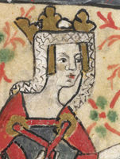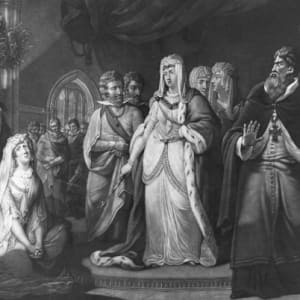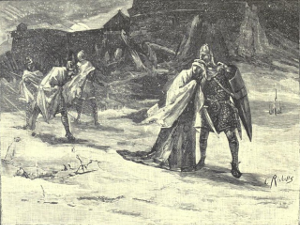Empress Matilda: 'Lady of the English'
The Empress Matilda, also known as Queen Maud, was the daughter of a king, the wife of two kings, and the mother of another. She was also a claimant to the English throne during a 12th-Century civil war known as The Anarchy. 
Matilda was born in 1102, the daughter of Matilda of Scotland, a descendant of Alfred the Great, and England's King Henry I. Her younger brother was William Aetheling. She also had a half-brother named Robert of Gloucester. Through her mother's Scottish heritage, she was also the niece of then-Scottish King David I. Matilda's father married her off to Germany's King Henry V in 1114, when Matilda was 12. Henry wanted to be named Holy Roman Emperor and needed both a wife and a lot of money; Matilda's father provided both. Henry V was indeed named Holy Roman Emperor, and Matilda was crowned Empress. The two were married for more than a decade and had no children. In 1120, Matilda's brother, William, died in the White Ship sinking, an accident that claimed the lives of nearly 300 people. William's death left the English king with one surviving heir: Matilda. Emperor Henry died in 1125. His throne was seized by one of his enemies. Matilda returned to England. Matilda's father insisted that his nobles agree to name her the reigning monarch after his death, and they took an oath to that effect in 1127. The following year, Matilda married again, this time to a younger man. She was 25 when she married Geoffrey of Anjou, who was 14. The couple did not like each other and lived apart much of the time. They did have three children, the oldest of which was named Henry. 
Matilda's father, Henry I, died in 1135 while visiting his daughter and grandsons. He had again pressed his nobles to support his daughter's claim to the throne before he died, and they had again agreed. Once he was dead, however, the nobles had second thoughts. England had not had a female ruler. Matilda was also viewed as a foreigner because of her marriage to a German emperor and a French count. Henry's nephew Stephen claimed the throne, with the backing of the English Church and a large number of barons. Two important powerful men who did not support Stephen's taking the throne were Matilda's half-brother, Robert of Gloucester, and her uncle, King David I of Scotland. The Scottish king led an army into northern England, claiming disputed lands; Stephen responded by leading his own force northward. The result was a treaty that involved David's getting a large amount of land, including some owned by barons who felt betrayed by Stephen's actions and switched sides. Meanwhile, Matilda's husband, Geoffrey of Anjou, had launched an invasion of neighboring Normandy, which was technically under the control of the English crown. Matilda herself arrived in England in 1139 to press her claim as the legitimate heir to the throne; at the same time, her half-brother, Robert of Gloucester, gathered a large number of men to his side, in support of Matilda. The two opposing forces parried and thrusted throughout southern England, taking some castles and towns. In one particularly fortuitous set of events, Stephen himself was captured at the Battle of Lincoln in 1141. Matilda then marched on London, intending to be crowned Queen. She met with such fierce resistance from the local people, including an army hastily put together at the behest of Stephen's queen, also named Matilda, that she left. About this time, she came to be called Lady of the English (since she was not crowned queen). Robert of Gloucester was taken prisoner later that year, and Matilda agreed to release Stephen in exchange for Robert. The Anarchy continued. 
Matilda herself was captured in 1142 and held in Oxford Castle. She made a daring escape in the middle of winter by wearing a white mantle to camouflage herself as she walked over the frozen Thames River. When Robert died in 1147, Matilda was no nearer to being queen than she was eight years earlier, when she landed triumphantly on English soil. She had lost other supporters as well, to death or to the Second Crusade. She went to Normandy and never returned. Her husband died in 1151. Her oldest son, Henry, took up his mother's cause and launched a handful of incursions into southern England. Henry was popular with some powerful nobles but didn't have the capacity to overthrow Stephen's forces. The two powerful men agreed to a truce of sorts, at Wallingford. That agreement has come to be known as the Treaty of Wallingford and the Treaty of Winchester. The men agreed that Stephen would remain on the throne for the rest of his life and that he would name Henry as his successor. Stephen died in 1154, and Henry became King Henry II of England. Matilda spent the rest of her life in Normandy, ruling in her son's name. He relied on her advice in political matters. In particular, she tried to mediate the growing dispute between Henry and Archbishop of Canterbury Thomas Becket. She also successfully defused a handful of other diplomatic crises. Matilda died in 1167. Her tombstone read, in part: "Here lies Matilda, the daughter, wife, and mother of Henry." |
|
Social Studies for Kids
copyright 2002–2026
David White




